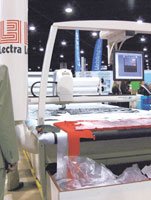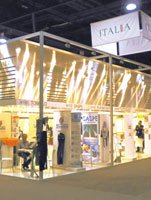One-Stop Shopping for Technology
SPESA, Techtextil and ATME-I co-located trade shows offer preview of what’s to come in apparel technology.
ATLANTA—Visitors to the May 18–20 run of the SPESA Expo, Techtextil and ATME-I Megatex 2010—dubbed Textile & Sewn Products Industry Week—got a glimpse of the future with the three shows’ offerings of the latest in apparel technology, sewing and spinning equipment, and technical textiles.
And thanks to a recently forged partnership between SPESA and Techtextil organizers, the apparel and textile industry will have another opportunity to scout for new technology at a new show launching in the United States in 2012.
The Sewn Products Equipment & Suppliers of the Americas, the nonprofit organization that organizes the SPESA show, and Messe Frankfurt, the German trade show producer that puts on Techtextil and nearly 100 other international trade fairs, have joined forces to produce a new show, called Texprocess, that will focus on sewn-products equipment and technology.
The new trade show will bow in concert with Techtextil’s 2011 run in Frankfurt, Germany, then head to the United States, where it will again be held concurrently with Techtextil. Show dates for the first Texprocess Americas are set for April 24–26, 2012, in Atlanta. The show will be held every other year in the United States. Texprocess Americas will take the place of the SPESA Expo, although SPESA will continue as a partner for the U.S. run of the new show. (For the Frankfurt edition, Texprocess has secured the support of two international trade associations, the VDMA Garment and Leather Technology group and the China Sewing Machinery Association.)
“We had a vision of having a total supply-chain show,” said Dave Gardner, managing director of SPESA, which is based in Raleigh, N.C. “We feel very, very encouraged that this idea is the idea of the future.”
Attendees at the recent Textile & Sewn Products Industry Week got a glimpse of that future on the show floor of the Georgia World Congress Center, where SPESA exhibitors ranged from equipment suppliers—including Gerber Technology, Lectra, Assyst Bullmer, Brother International Corp. and Consew—to software providers, including OptiTex, Lawson, Siemans, PAD Systems, FastFit360 and Alvanon. The show also featured fabric, yarn and fiber suppliers, as well as ancillary services. Setting the stage
Adjacent to SPESA was Techtextil North America and ATME-I (American Textile Machinery Exhibition-International), which showcases textile machinery, supplies and services for yarn and fiber makers, as well as mills, printers and dyehouses. One badge allowed access to all three trade shows. The three-show format helped draw a range of attendees, including many international attendees, according to Gardner.
“The newer technology brings in more mills, more fabrics and more trims,” he said. “In the U.S., our advantage is our technology.”
By co-locating with Techtextil, SPESA exhibitors also saw a wide range of attendees, including several from non-apparel fields such as automotive and furniture design and other industrial applications.
“The big benefit is because the machinery manufacturers and the garment industry are looking for new markets where they can produce new products,” said Stephan Seitz, Texprocess project director. “Garment visitors coming to Texprocess will be looking at new equipment and functional materials.”
There will also be new opportunities for the makers of technical textiles, according to Michael Janecke, brand manager for Techtextil, which last year saw a drop-off in American attendees at the Frankfurt show but saw more than 120 companies exhibit for the first time.
“We see a growing potential for Techtextil,” Janecke said. “The exhibitor potential is constantly growing. Start-up companies [tend to] start in their region; they don’t tend to go [immediately] for international shows.”Shopping for technology
SPESA’s exhibitors included technology solutions providers such as Siemens, which was demonstrating its product lifecycle management software, Siemens PLM.
“It’s a good show for us,” said Daniel J. Staresinic, leader of industry and vertical marketing for Siemens Industry Automation. “It covers the entire spectrum from machinery to services, including software and automation.”
Siemens representatives were meeting with both large and small companies at the show.
“Our solution applies across the board,” Staresinic said. “It also applies across multiple merchandise categories. There’s been quite a bit of interest in how to streamline the entire design, production and manufacturing process. We provide a foundation to manage that process.”
Executives at Lectra were similarly pleased with the caliber of attendees at the show.
“The quality of contacts is better than we had hoped for,” said Roy Shurling, president of the French company, whose U.S. headquarters are in Marietta, Ga. “We met with a lot of VPs and decision makers. People seem more confident, and they’re going back to growth mode.”
Lectra’s booth was buzzing with attendees watching one of the company’s automated cutters in action or getting an overview of its latest software releases, including its PLM solution, Lectra Fashion PLM V2R2, which will be available in July. Among the new updates to the software are automated costing and centralized order tracking.
Yoram Burg, president of OptiTex U.S.A., the New York–based division of the Petah-Tikva, Israel–based 2-D and 3-D CAD company, said he had scheduled appointments with more than 20 companies prior to the show and also had several walk-in meetings at the show—“many of them significant-size companies,” he said.
Last year was a growth year for OptiTex—“over 20 percent,” Burg said. “It’s the time for technology. [Companies are asking themselves,] ’Am I lined up with the right tools for the new economy?’”
OptiTex’s Burg pointed out that innovative companies often thrive during an economic downturn. “Google was born out of the last recession,” he said. “Imagine what we’re going to get out of this one.” Executive networking
SPESA offered plenty of networking opportunities, as well. There were pre-show workshops on lean business practices and supply-chain strategies. Organizers hosted a VIP gala on May 17 at the Georgia Aquarium, where guests mingled over a buffet dinner and wandered through the aquarium’s cavernous exhibits. Ticket proceeds benefited the American Apparel & Footwear Association’s education foundation.
Los Angeles–based Tukatech sponsored a headliner breakfast on global sourcing on May 18. Executives from The Gap, Chico’s FAS’ Soma intimates division, VF Corp., McMurray Fabrics, [TC]2 and O’Rourke Group Partners LLC spoke at the event.
There was also an extensive seminar lineup—at both SPESA and Techtextil—where industry insiders discussed everything from the future of several international trade agreements to new innovations in technical and fashion textiles.
Getting technicalTechtextil North America is now in its second season in the United States and its first in Atlanta. The show, which is a sampling of the much larger Frankfurt show, focuses on technical textiles and nonwoven materials for a variety of industries, including apparel. This year, organizers created a series of 12 icons to help attendees identify exhibitors with their areas of industrial expertise. For example, the “Clothtech” identified exhibitors who specialized in technical components for apparel, shoes and bags. There was an icon for medical textiles (“Medtech”); one for materials used in automotive, shipbuilding, aircraft and space-travel applications (“Mobiltech”); one for home-interiors applications (“Hometech”); and another for construction and engineering textiles (“Buildtech”). Textiles and materials for apparel applications could also be found under the headings “Sporttech” (active, sports and outdoor apparel) and “Protech” (protective and industrial apparel).
New Techtextil exhibitor Vulcana was fielding inquires from several industries.
The Westfield, N.J.–based company recycles used tires into a sheet rubber material called RubbRe, which can be used in a variety of applications, including accessories and luggage. The company’s products are currently part of the National Design Triennial exhibition at the Cooper-Hewitt National Design Museum in New York.
A lot of corporations are requiring more of their materials be recycled or recyclable, said company owner Dianne Denommee, who was manning the booth with Aline Denommee, her sister. “The time is good for us,” Dianne Denommee said.
The eco aspect of RubbRe was a draw for many attendees who dropped by the booth, said Aline Denommee. “The cut-and-sew people are saying their customers are looking for something new, something recycled,” she said. “Maybe they’re using PVC, and maybe they want to use something different.”

























